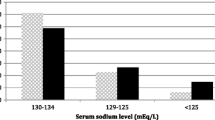Abstract
Background
Hyponatremia is the most common electrolyte disorder and it has been associated with increased mortality.
Aims
This study evaluated hyponatremia as a prognostic factor for severity and mortality.
Methods
We compared the prevalence of hyponatremia among patients who died during the year 2017 (from 1 January 2017 to 31 December 2017) with the prevalence of hyponatremia among subgroups of patients, i.e. outpatients, patients hospitalized for more than 2 days and patients admitted in the intensive care unit (ICU). We also described the mortality rate and the prevalence of comorbidities among hyponatremic patients, according to hyponatremia degree (slight, moderate, severe), basal characteristics, comorbidities and their outcome (discharged, hospitalized or died).
Results
In our population of a public hospital setting, hyponatremia was present at admission in 17% of deaths, and the comparison between hyponatremic and normonatremic patients in terms of mortality confirms the hypothesis that this disorder is in anyway strictly associated with vulnerability and with a poor prognosis.
Conclusions
We conclude that hyponatremia is a predictive marker for a bad clinical course, therefore patients with this electrolyte disorder should be carefully monitored.



Similar content being viewed by others
References
Asadollah K, Beeching N, Gill G (2006) Hyponatraemia as a risk factor for hospital mortality. QJMed 99(12):877–880. https://doi.org/10.1093/qjmed/hcl120
Garrahy A, Cuesta M, Murphy B et al (2021) Active management of severe hyponatraemia is associated with improved mortality. CJ Eur J Endocrinol 184(1):9–17. https://doi.org/10.1530/EJE-20-0577
Baran D, Hutchinson TA (1984) The outcome of hyponatremia in a general hospital population. Clin Nephrol 72–76
Cuesta M, Garrahy A, Slattery D et al (2017) Mortality rates are lower in SIAD, than in hypervolaemic or hypovolaemic hyponatraemia: results of a prospective observational study. Clin Endocrinol (Oxf) 87(4):400–406. https://doi.org/10.1111/cen.13388. Epub 2017 Jul 13
Gill G, Huda B, Boyd A et al (2006) Characteristics and mortality of severe hyponatraemia: a hospital-based study. Clin Endocrinol (Oxf) 65(2):246–249. https://doi.org/10.1111/j.1365-2265.2006.02583.x
Hoorn EJ, Zietse R (2011) Hyponatremia and mortality: how innocent is the bystander? Clin J Am Soc Nephrol 6(5):951–953. https://doi.org/10.2215/CJN.01210211
Sajadieh A, Binici Z, Mouridsen MR et al (2009) Mild hyponatremia carries a poor prognosis in community subjects. Am J Med 122(7):679–686. https://doi.org/10.1016/j.amjmed.2008.11.033
Bratusch-Marrain PR, DeFronzo RA (1983) Impairment of insulin-mediated glucose metabolism by hyperosmolality in man. Diabetes 32(11):1028–34. https://doi.org/10.2337/diab.32.11.1028
Kozeny GA, Murdock DK, Euler DE et al (1985) In vivo effects of acute changes in osmolality and sodium concentration on myocardial contractility. Am Heart J 109(2):290–296. https://doi.org/10.1016/0002-8703(85)90596-4
Chawla A, Sterns RH, Nigwekar SU et al (2011) Mortality and the serum sodium: do patients die with or from hyponatremia? Clin J Am Soc Nephrol 6(5):960–5. https://doi.org/10.2215/CJN.10101110
Mohan S, Gu S, Parikh A et al (2013) Prevalence of hyponatremia and association with mortality: results from NHANES. Am J Med 126(12):1127–37.e1. https://doi.org/10.1016/j.amjmed.2013.07.021
Singla I, Zahid M, Good CB et al (2007) Effect of hyponatraemia on outcome in patients with non-ST-elevation acute coronary syndrome. Am J Cardiol 100(3):406–8. https://doi.org/10.1016/j.amjcard.2007.03.039
Gheorghiade M, Rossi JS, Cotts W et al (2007) Characterization and prognostic value of persistent hyponatraemia in patients with severe heart failure in the ESCAPE trial. Arch Intern Med 167(18):1998–2005. https://doi.org/10.1001/archinte.167.18.1998
Heuman DM, Abou-Assi SG, Habib A et al (2004) Persistent ascites and low serum sodium identify patients with cirrhosis and low MELD scores who are at high risk for early death. Hepatology 40(4):802–10. https://doi.org/10.1002/hep.20405
Kim DJ, Lee SK, Jo JW, Kim SJ et al (2006) Prognosis after liver transplantation predicted by preoperative MELD score. Transplant Proc 38(7):2095–2096. https://doi.org/10.1016/j.transproceed.2006.06.031
Biggins SW, Kim WR, Terrault NA et al (2006) Evidence-based incorporation of serum sodium concentration into MELD. Gastroenterology 130(6):1652–1660. https://doi.org/10.1053/j.gastro.2006.02.010
McCarthy K, Conway R, Byrne D et al (2019) Hyponatraemia during an emergency medical admission as a marker of illness severity & case complexity. Eur J Intern Med 59:60–64. https://doi.org/10.1016/j.ejim.2018.08.002
Vega J, Manríquez F, Madrid E et al (2011) Hyponatremia on admission to the emergency room as a risk factor for hospital mortality. Rev Med Chil 139(8):985–91
World Medical Association Declaration of Helsinki: ethical principles for medical research involving human subjects (2013) JAMA 310(20):2191–4. https://doi.org/10.1001/jama
Ball S, Barth J, Levy M, Society for Endocrinology Clinical Committee (2016) Society for endocrinology endocrine emergency guidance: emergency management of severe symptomatic hyponatraemia in adult patients. Endocr Connect 5(5):G4–G6. https://doi.org/10.1530/EC-16-0058
Istituto Nazionale di Statistica ISTAT (2012) ISTAT, https://www.istat.it/it/files//2011/01/D4bis_2012.pdf
Hao J, Li Y, Zhang X, Pang C et al (2017) The prevalence and mortality of hyponatremia is seriously underestimated in Chinese general medical patients: an observational retrospective study. BMC Nephrol 18(1):328. https://doi.org/10.1186/s12882-017-0744-x
Zheng Y, Zheng FP, Li H (2020) Zhonghua Nei Ke Za Zhi. 59(1):29–34. https://doi.org/10.3760/cma.j.issn.0578-1426.2020.01.005
Balling L, Schou M, Videbæk L et al (2011) Prevalence and prognostic significance of hyponatraemia in outpatients with chronic heart failure. Eur J Heart Fail 13(9):968–73. https://doi.org/10.1093/eurjhf/hfr086
Bennani SL , Abouqal R, Zeggwagh AA et al (2003) Incidence, causes and prognostic factors of hyponatremia in intensive care. Rev Med Interne 24(4):224–9. https://doi.org/10.1016/s0248-8663(02)00811-1
Elmi G, Faustini-Fustini M, Zaccaroni S et al (2011) The hyponatremias. Ital J Med 5(3):156–68
Waikar SS, Mount DB, Curhan GC (2009) Mortality after hospitalization with mild, moderate, and severe hyponatremia Am J Med 122(9):857–65. https://doi.org/10.1016/j.amjmed.2009.01.027
Holland-Bill L, Christiansen CF, Heide-Jørgensen U et al (2005) Hyponatremia and mortality risk: a Danish cohort study of 279 508 acutely hospitalized patients. Eur J Endocrinol 173(1):71–81. https://doi.org/10.1530/EJE-15-0111
Author information
Authors and Affiliations
Corresponding author
Ethics declarations
Ethics approval
The authors declare that this research does not involve any experiments on animals or humans.
Conflict of interest
The authors declare no competing interests.
Additional information
Publisher's Note
Springer Nature remains neutral with regard to jurisdictional claims in published maps and institutional affiliations.
Rights and permissions
About this article
Cite this article
Falchi, A.G., Mascolo, C., Sepe, V. et al. Hyponatremia as a predictor of outcome and mortality: results from a second-level urban emergency department population. Ir J Med Sci 192, 389–393 (2023). https://doi.org/10.1007/s11845-022-02953-8
Received:
Accepted:
Published:
Issue Date:
DOI: https://doi.org/10.1007/s11845-022-02953-8




